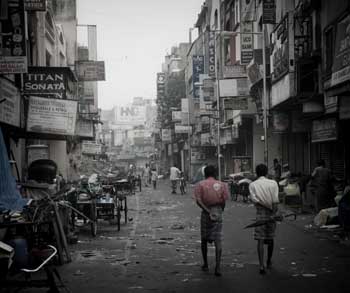
![]()
Welcome • |
About
Us • |
The International Writers Magazine: India
• Colin Todhunter
Look up, but certainly look down as well. Just watch your step. There are a million stones to negotiate and a thousand bits of loose concrete. There’s the odd discarded sandal and the numerous potholes. There are countless strands of discarded plastic that were used for strapping boxes to carts, sacks to trucks or tubes together as they were all transported into, out of or around the area.
There are streams of liquid. Burst drain liquid, dog and cow liquid. Some stale and dried, some still flowing. Negotiate a path around, not through. There are mini mountains of sludge from drains cleared by municipal workers with their metal rods. There are mini mountains of other stuff too. Animal stuff.
Pungent odours burn the back of the throat. Softer ones in the air as well. They come from street-side stoves that cook dosas, idlis, sambar and spicy bites for the labouring masses of this area. They also seep from sacks of spices thrown down hard on surfaces outside wholesale traders from carts and trucks. Familiar aromas that you just can’t put a name to. And unfamiliar ones that you attempt to put a name to.
Body swerve one way and then the other because there are one hundred accidents waiting to happen down these narrow lanes. Lanes without pavements, lanes without end, lanes without respite from activity and chaos.
Within a centimetre of your body and possibly an inch of your life, big, brightly panted trucks with ‘Blow horn at night’ painted on the rear and hand drawn pictures of frightening demons and reassuring gods growl past. Cyclists, cycle rickshaws, overloaded cycle carts packed high with boxes or six-metre long tubes and men with huge, heavy sacks also rush by. They all have right of way.
Boxes containing metal pressure valves, fluorescent light tubes, surgical appliances, herbal medicines and TVs. Sacks containing flour, rice, spices and produce. Tubing made of plastic or metal. Tubing for underground cables, electrical machinery and all manner of components and parts for ships, factories and houses. Think of anything that humanity could and does use. Then open your eyes here and see, hear, feel, taste or smell it.
Shree Grinders, Laksmi buildings, Ganesh Traders. The names of gods or symbols denoting greatness adorn the signage in this area. This area of mundane, earthly, back-breaking endeavour, which some may think god forsook long ago. This area of thousands of one-room workshops and trading offices and wholesale merchants, milling, grinding, beating, buying, selling, importing and exporting. Textiles wrapped around rolls. Sheets of plastic rolled around tubes. Whole families clung around seats of mopeds. Five to a seat. Sacks of garlic or apples lifted on the back from trucks or cycle carts into premises. Sacks of spices on the hardened dark-skinned backs of tough-looking men. No fork-lift trucks, no other lifting machinery, no footwear, no health or safety. Just taught bare bodies with lunghis wrapped around the lower half. No protruding bellies or chubby faces from over indulging in idlis, dosas or rice meals either. After all, these men are not from middle class, increasingly obeseIndia.
A stray dog wanders through the jungle of legs. Its teats almost touch the floor. Another mongrel with an ear half missing munches on what must be a delectable piece of garbage.
And two minutes’ walk away, a stone’s throw from all the commerce, hauling, loading and grind, small kids on Mint Street with smiling faces and satchels make their way from school. Old men beaten down by the years hobble back into dark hallways and wait to die another day.
Huge, dark saucer eyes and pale, young north Indian skin. Veil pulled over head and plastic bags containing fabrics from ‘Fancy Saree Fashion House’ dangle from arms. Bejewelled princesses don’t just exist in fairytales. They glide through mud while talking on cell phones down the narrow alleys off Mint Street. And the bag does not lie – the contents will almost certainly be ‘fancy’. The colours and patterns are much more eye-catching, daring and flamboyant around here than elsewhere in Chennai. And worn differently: sarees often pulled over the head.
Neighbourhood centres, marriage halls and Jain and Hindu temples. Apartment blocks, back lane schools and small hospitals. Sowcarpet isn’t just an area of commerce and hard labour, it’s also an area of community… many communities from different regions of India, of different faiths of different appearances, of different wealth brackets.
This is an area of migrants. Migrants who originally rented rooms from local Tamil people during the last century and even before. The locals eventually sold up and moved out completely to reside elsewhere.
In what is possibly the most overcrowded part of Chennai, there are cows, dogs, garbage in the street and of course people, who reside in a sea of four to seven story apartment blocks with little or no gap in between and which seem to go on never-ending into the distance, whichever way you look at street level. They sprawled sideways and upwards to accommodate migrants from North India, many of whom had larger families than the original Tamil inhabitants of the area. The fact that their neighbours from towns and villages up in Gujarat, Rajasthan and elsewhere often followed didn’t help matters. Sowcarpet loosely translates as moneylender or pawnbroker. Such business people formed part of the North Indian population who came here. And, have no doubt, appearances can be deceptive: there is wealth in this area.
Moneylenders (or pawnbrokers) do not remain poor. Neither do wholesale traders or the many jewellers in the area. The quality of at least some of the apartment blocks, the facades at least, indicate a certain degree of wealth remains in the area. And the well-off continue to reside in these types of areas throughout India because they rely on the local community, its ‘social capital’ and the associated networks to do business, to keep ahead of the game.
Back in the 1700s Telegu speaking people migrated to Mint Street. People from Gujarat, Rajasthan, Uttar Pradesh,Bihar and other states eventually came too. This eclectic, mix has helped make Sowcarpet what it is today. In some respects, it has helped it to keep ahead of the game. Not in terms of decent urban planning, ‘prettiness’ or cleanliness, but certainly in terms of heart, soul and vibrancy.
© Colin Todhunter November 2013
colins blog
Up Close and Personal in Chennai
Colin Todhunter
It’s a walk through the Triplicane and Royapettah areas of Chennai in July. It’s always hot here...
Keeping it Clean on Mint Street,
Colin Todhunter
An old woman in rags, performs the sweeping-street-dust-into-the-air ritual twice daily. At least until the dust settles again



